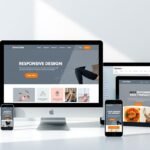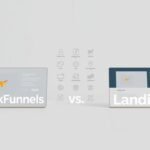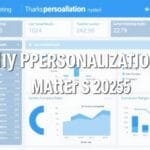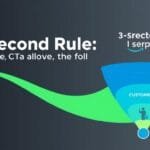In this comprehensive review, we’ll explore how Optimizely makes A/B testing accessible and effective for businesses of all sizes, examine real-world use cases, and provide a practical guide to get you started on your testing journey.
Optimizely’s intuitive dashboard makes monitoring your A/B tests straightforward
What Makes Optimizely Stand Out for A/B Testing?
In a landscape filled with testing tools, Optimizely has established itself as a leader for good reason. The platform combines powerful capabilities with user-friendly interfaces, making sophisticated experimentation accessible to both technical and non-technical team members.
Visual Editor: No Coding Required
Optimizely’s visual editor allows anyone to create test variations without writing code. You can modify text, images, buttons, and layouts through a simple point-and-click interface. This democratizes testing across your organization, enabling marketers and designers to implement their ideas without developer resources.
Statistical Rigor Built In
One of Optimizely’s greatest strengths is its statistical engine. The platform automatically calculates statistical significance, helping you determine when results are reliable versus when they might be due to random chance. This prevents the common mistake of ending tests too early or drawing conclusions from insufficient data.
Multi-Page Testing
Unlike basic tools that only test single pages, Optimizely allows you to create experiments that span multiple pages or entire user journeys. This is crucial for understanding how changes affect the complete customer experience, not just isolated interactions.
Seamless Integrations
Optimizely integrates with popular analytics platforms, CRMs, and marketing tools, allowing you to connect testing data with your broader marketing ecosystem. This creates a more complete picture of how experiments impact your business metrics beyond simple conversion rates.

Optimizely makes it easy to compare variations side-by-side and track performance differences
Ready to see these features in action?
Explore Optimizely’s capabilities with a hands-on demonstration.
Step-by-Step Guide to Setting Up an A/B Test with Optimizely
Creating effective A/B tests requires more than just changing button colors. Let’s walk through the process of setting up a proper experiment using Optimizely’s platform.

The complete A/B testing workflow in Optimizely from hypothesis to implementation
1. Collect Data and Form a Hypothesis
Before launching any test, you need a clear hypothesis based on existing data. Use analytics tools to identify opportunities for improvement, such as pages with high drop-off rates or underperforming conversion elements.
A good hypothesis follows this format: “By changing [element], we expect [outcome] because [rationale].” For example: “By simplifying our signup form from 8 fields to 4, we expect a 15% increase in form completions because reduced friction typically improves conversion rates.”
2. Create Your Variations
Once you have a hypothesis, use Optimizely’s visual editor to create your test variations:
- Log into your Optimizely account and create a new experiment
- Select the pages where your test will run
- Use the visual editor to make changes to your variation (B version)
- Preview how your variations will look on different devices
- QA your changes to ensure everything functions properly
3. Set Up Audience Targeting
Determine who will see your experiment. Optimizely allows you to target visitors based on various criteria:
- Traffic source (direct, search, social, etc.)
- Geographic location
- Device type (desktop, mobile, tablet)
- New vs. returning visitors
- Custom behavioral segments
4. Define Your Goals and Metrics
Clearly define what success looks like for your experiment. Optimizely allows you to track multiple metrics:
- Primary goal: The main action you want users to take (e.g., completing a purchase)
- Secondary goals: Additional metrics to monitor (e.g., add-to-cart rate, time on page)
- Revenue tracking: Measure the monetary impact of your variations
5. Launch, Monitor, and Analyze
With everything set up, it’s time to launch your experiment:
- Start with a traffic allocation of 50/50 between control and variation
- Monitor results regularly but avoid drawing conclusions too early
- Wait for statistical significance (Optimizely will indicate when results are reliable)
- Analyze both primary and secondary metrics to understand the full impact
- Document learnings regardless of whether your hypothesis was confirmed
“It’s about being humble… maybe we don’t actually know what’s best, let’s look at data and use that to help guide us.”
Real-World A/B Testing Use Cases with Optimizely
The true power of A/B testing with Optimizely becomes apparent when you see how companies across industries have used it to drive meaningful improvements. Let’s explore three concrete examples:
E-commerce: Product Page CTA Optimization
An online retailer was experiencing lower-than-expected conversion rates on their product pages. Using Optimizely, they tested multiple variations of their “Add to Cart” button:
The Test:
- Control: Standard blue “Add to Cart” button
- Variation A: Changed button color to high-contrast orange
- Variation B: Modified text to “Buy Now” with same blue color
- Variation C: Combined orange color with “Buy Now” text
The Results:
- Variation A: 6% increase in click-through rate
- Variation B: 2% increase in click-through rate
- Variation C: 14% increase in click-through rate and 9% increase in completed purchases
The combined changes in Variation C created a synergistic effect that neither change could achieve alone. This highlights the importance of testing multiple variables and their interactions.

The winning variation showed a 14% increase in click-through rate compared to the control
SaaS: Pricing Page Layout Optimization
A software-as-a-service company wanted to improve conversion rates on their pricing page. They hypothesized that simplifying the page and highlighting annual plans would increase subscriptions.
The Test:
- Control: Standard pricing table with equal emphasis on monthly and annual plans
- Variation: Redesigned page with annual plans highlighted, showing the savings percentage, and featuring customer testimonials specifically about value
The Results:
- 12% increase in overall conversion rate
- 24% increase in annual plan selection
- 18% increase in average revenue per user
By emphasizing the value proposition of annual plans and incorporating social proof, the company not only increased conversions but also shifted their customer base toward higher-value subscriptions.
Media: Headline Testing for Click-Through Rates
A digital media company used Optimizely to test different headline formats for their articles to increase reader engagement.
The Test:
- Control: Standard declarative headline
- Variation A: Question-based headline
- Variation B: Number-based headline (“7 Ways to…”)
- Variation C: Curiosity-gap headline
The Results:
- Variation A: 5% increase in click-through rate
- Variation B: 29% increase in click-through rate
- Variation C: 19% increase in click-through rate
The number-based headlines significantly outperformed other variations, leading the company to implement this format more widely across their content strategy. Additionally, they discovered that readers who came through number-based headlines had 7% longer average session durations.
“In A/B testing, there are no true failures – only opportunities to learn. Every test, whether it shows positive, negative, or neutral results, provides valuable insights about your users.”
Pros and Cons of Using Optimizely for A/B Testing
While Optimizely offers powerful capabilities for A/B testing, it’s important to consider both its strengths and limitations to determine if it’s the right solution for your needs.
![]()
Key considerations when evaluating Optimizely for your A/B testing program
Optimizely Advantages
- User-friendly interface: Visual editor makes it accessible to non-technical team members
- Statistical rigor: Built-in statistical significance calculations prevent false conclusions
- Scalability: Handles high-traffic websites and complex testing scenarios
- Comprehensive features: Multi-page testing, personalization, and feature flagging
- Robust integrations: Works with major analytics platforms and marketing tools
Optimizely Limitations
- Pricing: Can be expensive for small businesses or startups
- Learning curve: Advanced features require time to master
- Implementation complexity: Enterprise features may require developer assistance
- Resource requirements: Getting the most value requires dedicated testing resources
- Feature overwhelm: Some users may not need all available capabilities
Is Optimizely Right for Your Business?
Optimizely is particularly well-suited for:
- Mid-size to enterprise businesses with dedicated optimization teams
- Companies with moderate to high website traffic (needed for statistical significance)
- Organizations committed to building a culture of experimentation
- Teams that need advanced features like personalization and feature flagging
Smaller businesses or those just starting with A/B testing might consider beginning with simpler, more affordable tools and graduating to Optimizely as their testing program matures.
Building a Culture of Experimentation with Optimizely
The most successful companies don’t just use A/B testing tools – they build a culture of experimentation that permeates their entire organization. Optimizely can be a catalyst for this transformation.
Key Elements of an Experimentation Culture
Leadership Buy-in
Executives must champion testing and be willing to let data challenge their assumptions. When leaders embrace experimentation, it sets the tone for the entire organization.
Democratized Testing
Empower team members across departments to propose and run tests. Optimizely’s user-friendly interface makes this possible without requiring technical expertise.
Learning from “Failures”
Reframe unsuccessful tests as valuable learning opportunities. Remember that only about 1 in 8 A/B tests produce winning results – the insights from “losing” tests are equally important.

The continuous cycle of experimentation drives ongoing optimization and business growth
Practical Tips for Implementation
- Start small: Begin with simple tests to build momentum and demonstrate value
- Create a testing roadmap: Prioritize tests based on potential impact and implementation effort
- Share results widely: Communicate both successes and learnings across the organization
- Celebrate the process: Recognize team members who contribute to the testing program, regardless of outcomes
- Document everything: Build a knowledge base of test results to inform future experiments
“The bigger a company is and the more senior folks are involved, the more people hesitate to experiment. To build a culture of experimentation, you need to rethink your approach.”
Pro Tip: According to Optimizely’s research from 127,000 experiments, tests with larger changes and more than 3 variations saw 10% more impact. Don’t be afraid to test bold ideas!
Conclusion: Is A/B Testing with Optimizely Right for You?
A/B testing is no longer a nice-to-have but a necessity for companies serious about optimizing their digital experiences. Optimizely provides a powerful platform that combines ease of use with sophisticated capabilities, making it suitable for organizations at various stages of testing maturity.
The key takeaways from our review:
- Optimizely excels at making A/B testing accessible while providing enterprise-grade features
- The platform’s statistical rigor helps prevent common testing mistakes
- Real-world results demonstrate significant improvements across e-commerce, SaaS, and media industries
- Building a culture of experimentation is as important as the tool itself
- While not the cheapest option, Optimizely offers value through comprehensive features and scalability
Remember that successful A/B testing isn’t about changing button colors – it’s about systematically improving your digital experiences based on data rather than opinions. As Dan Siroker, Optimizely’s co-founder notes, “It’s about being humble… maybe we don’t actually know what’s best, let’s look at data and use that to help guide us.”
Whether you’re just starting your testing journey or looking to scale an existing program, Optimizely provides the tools and infrastructure to transform how your organization makes decisions and creates digital experiences.
Ready to start your A/B testing journey?
Experience the power of data-driven optimization with Optimizely’s comprehensive platform.
Frequently Asked Questions About A/B Testing with Optimizely
How long should I run an A/B test in Optimizely?
Tests typically run for 1-2 weeks to account for traffic patterns, but the exact duration depends on your traffic volume and desired confidence level. Optimizely provides a sample size calculator and statistical significance indicators to help determine when you have enough data to make reliable decisions.
Does A/B testing affect SEO?
When implemented correctly, A/B testing with Optimizely won’t negatively impact your SEO. Google has stated that they permit and encourage A/B testing. To stay safe, follow best practices: use 302 (temporary) redirects instead of 301s, implement the rel=”canonical” attribute for multiple URL tests, and avoid cloaking (showing different content to search engines versus users).
What’s the difference between A/B testing and multivariate testing in Optimizely?
A/B testing compares two versions of a page with a single element changed, while multivariate testing examines multiple variables simultaneously to understand their combined impact. Optimizely supports both approaches, but multivariate tests require significantly more traffic to reach statistical significance since they test many combinations.
Can I use Optimizely for mobile app testing?
Yes, Optimizely offers Feature Experimentation (formerly Full Stack) that supports testing in mobile apps, server-side applications, and other digital products beyond websites. This requires developer implementation but provides powerful capabilities for testing throughout your product ecosystem.
How does Optimizely handle personalization?
Optimizely’s personalization capabilities allow you to deliver tailored experiences to different user segments based on behavior, demographics, or other attributes. According to Optimizely’s research, personalized experiences generate 41% more impact than general ones, making this a powerful extension of basic A/B testing.
Also read: Mixpanel vs Google Analytics: Which One Should You Choose in 2025?











